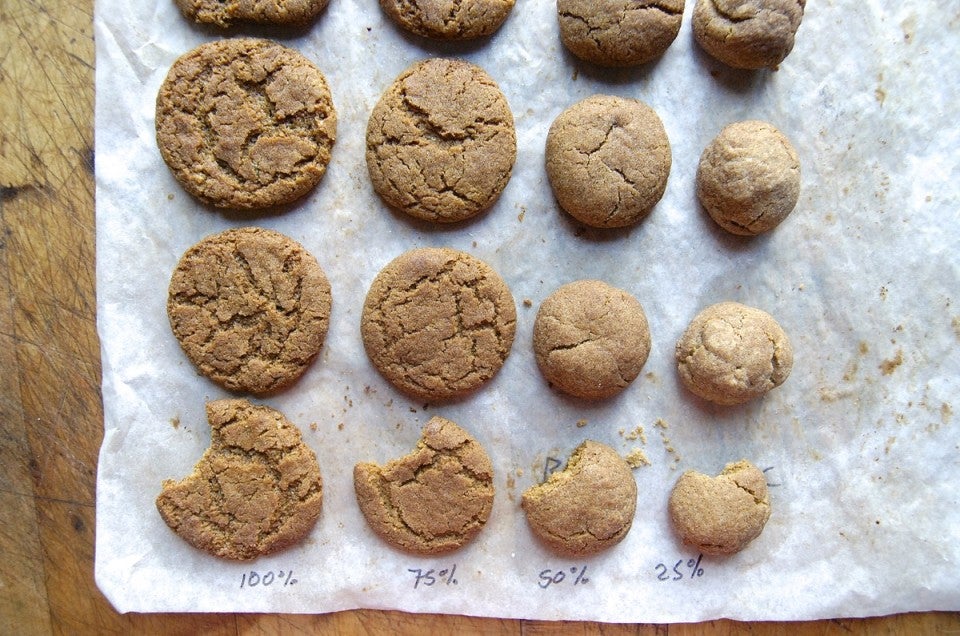


"Cut back on your sugar intake" and "enjoy an exquisitely delicious homemade chocolate chip cookie" seem like statements in direct opposition to one another, don't they? But after recently testing lower-sugar versions of eight assorted cookies and bars, I feel confident that saying "lower sugar" and "exquisitely delicious" aren't as oxymoronic as they seem.
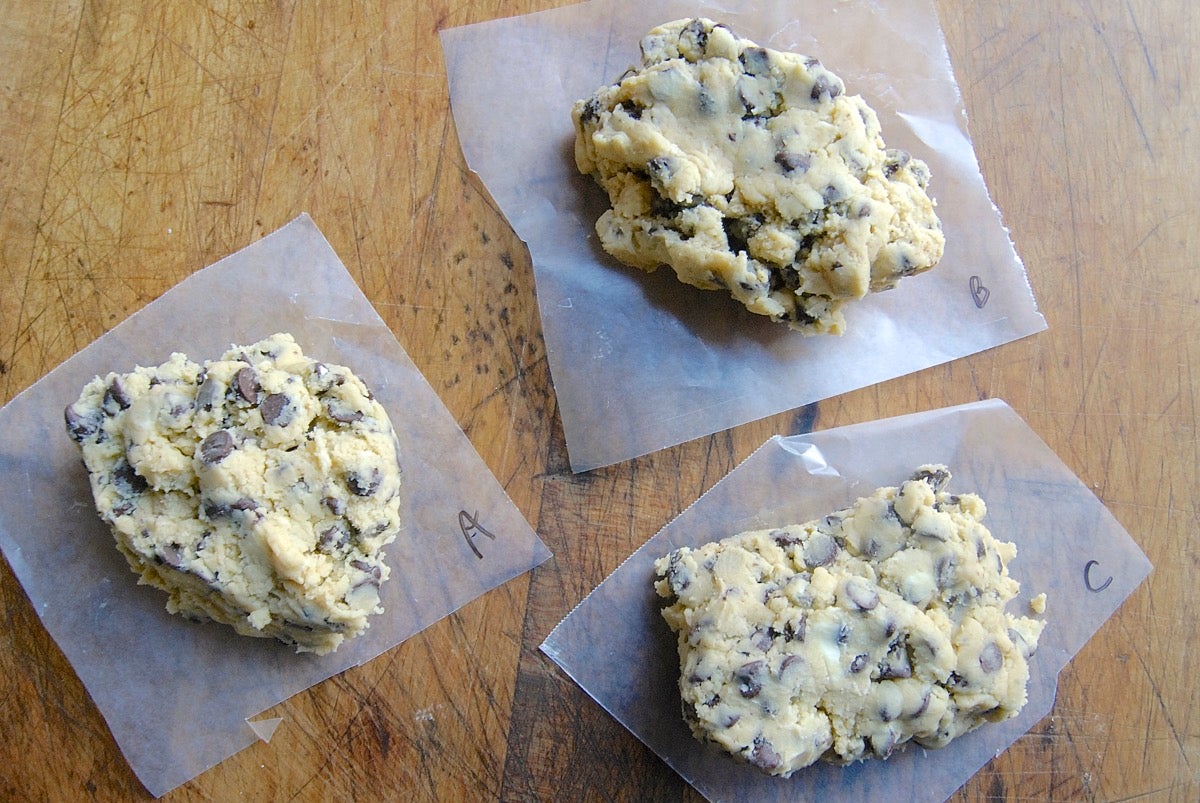
I begin this lower-sugar quest with recipes representing eight different types of cookies and bars:
I decide to bake four versions of each cookie or bar:
My goal: To see what happens if I simply cut the sugar in each recipe in half. And then to refine the test further by using baker's percentage to try to come up with some "universal truths" about cookies and sugar.
And what's this baker's percentage (a.k.a. baker's weight), you ask?
It's how professional bakers modify recipes — either scaling them up and down, or changing ingredient amounts.
Using the weight of the flour in the recipe as 100%, the recipe's other ingredient weights are determined based on their percentage of flour weight. For instance, for a cookie that uses 8 ounces of flour and 12 ounces of sugar, the baker's percentage of sugar is pegged at 150%. For a cookie using 8 ounces of flour and 6 ounces of sugar, the baker's percentage of sugar is 75%.
At the end of this post, I'll take all of my cookie data and draw some conclusions — tips you can use to reduce the sugar in any favorite cookie recipe. But first, let's look at the complete test results.
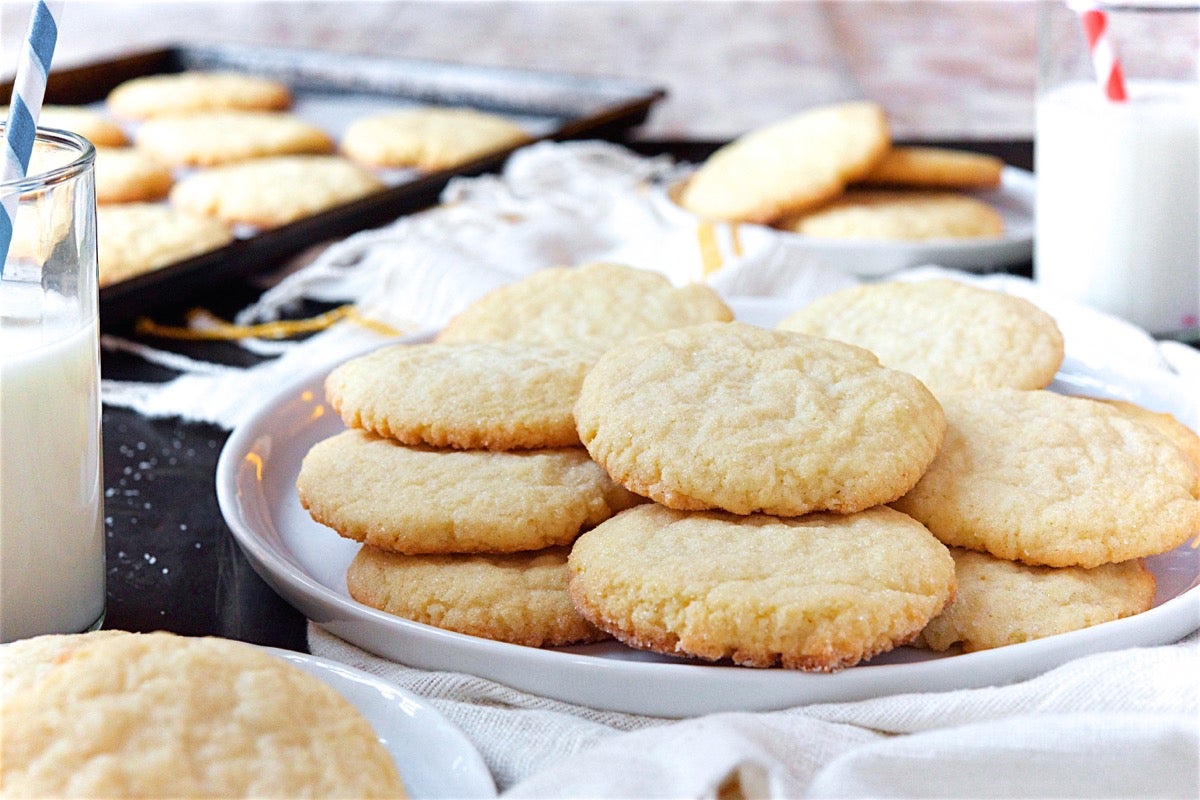
Our basic sugar cookie recipe produces a cookie that's a little crunchy around the edges, a bit moist in the center, and tender through and through.
What happens when you cut back on the sugar in this cookie?
This first test reveals results that will hold true throughout my testing:
The lower the sugar, the less cookies spread, the drier/more crumbly they are. Cookies with less sugar taste less sweet, of course. But beyond that, their flavor also becomes flat; sugar is a flavor enhancer much like salt is.
I'll provide tasting notes for each cookie, including a "pass" or "fail" rating — based very subjectively on whether or not I chose to finish the cookie, once I tasted it. For the original-recipe cookie (the control, "A"), I'll also include the baker's percentage of sugar, for reference.
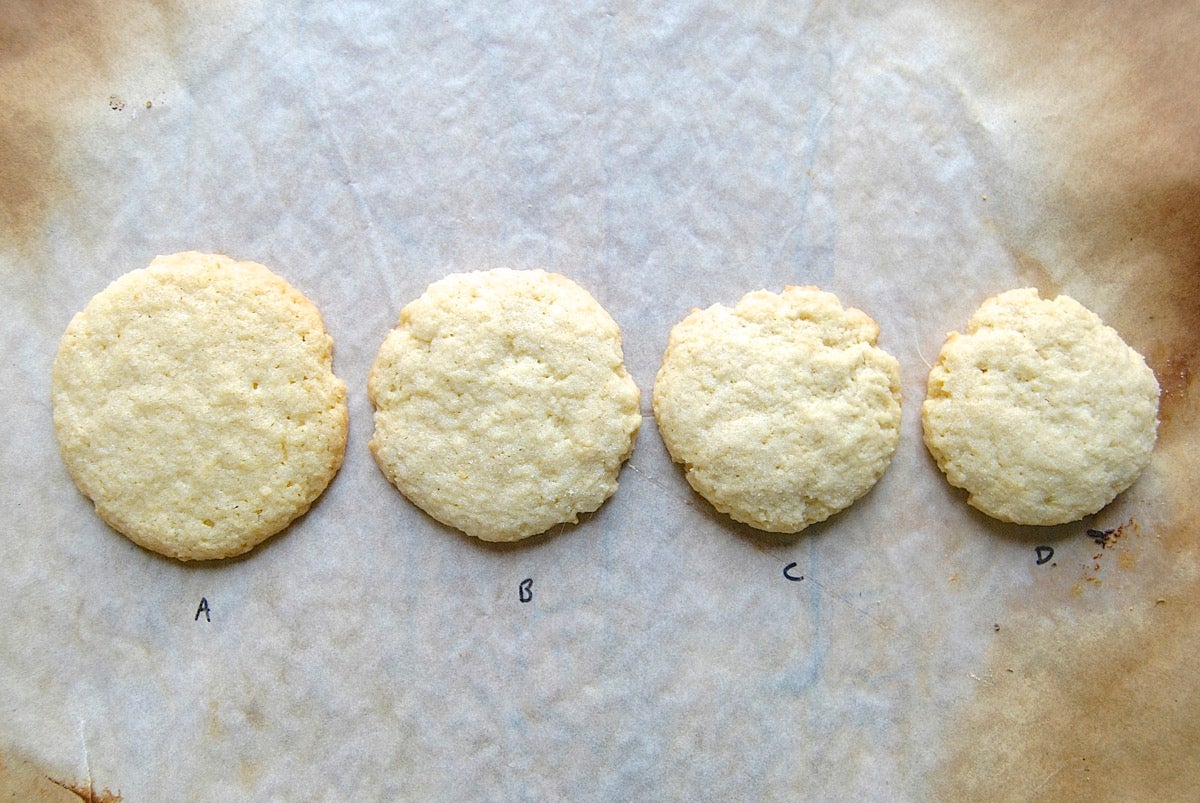
A) Original recipe (69% sugar): These cookies spread into nice disks. They're crunchy at the edges, softer/bendy in the center. Nicely sweet (but not overly so), they taste like a sugar cookie should. PASS
B) 50% sugar, baker's percentage: Not as sweet, not as crunchy, but you’d still think you were eating a cookie. Definitely cookie-like, in both flavor and texture. PASS
C) Half the sugar in the original recipe: Very mildly sweet; the butter flavor starts to come through. Especially if drizzled with icing, these would be enjoyable. PASS
D) 25% sugar, baker’s percentage: Texture is almost like pie crust: tender/dry. They're obviously lacking sugar; flavor is dull. FAIL
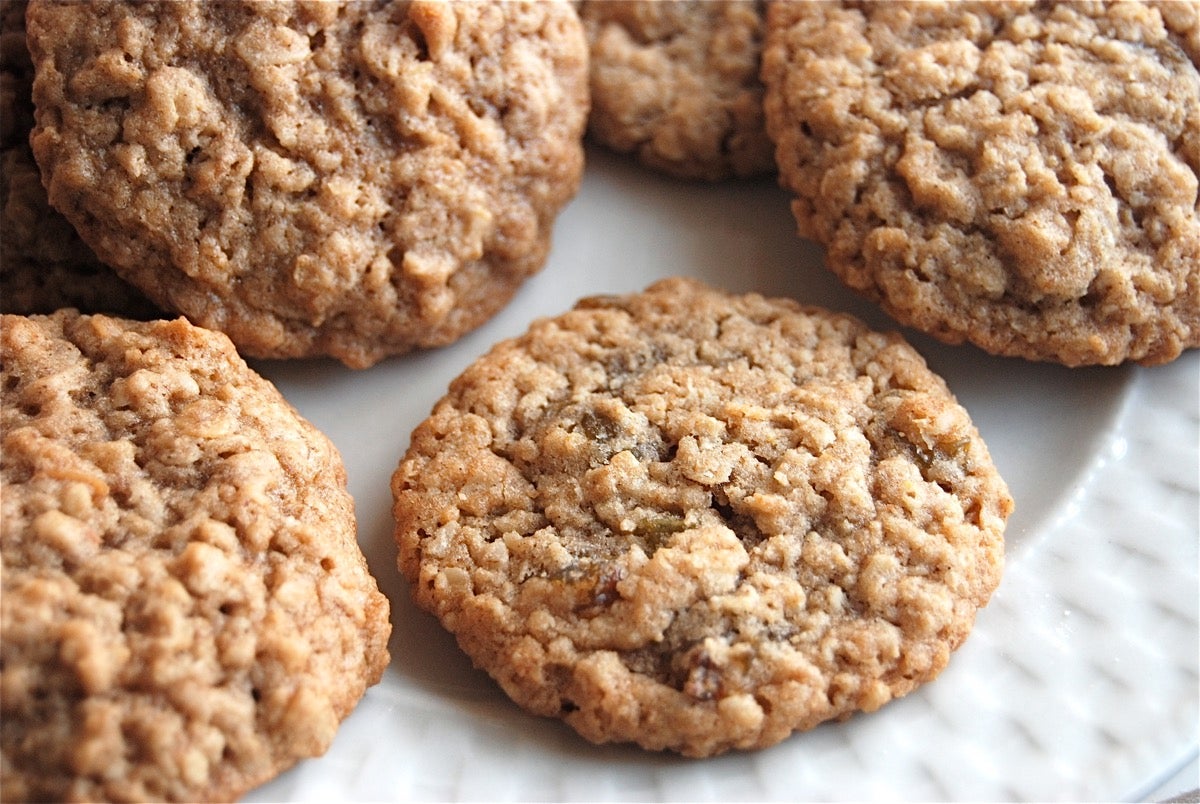
These old-fashioned oatmeal cookies are flat, very moist, and bend rather than break. As with sugar cookies, reducing their sugar reduces spread; all but the control cookies are round mounds, rather than flat disks.
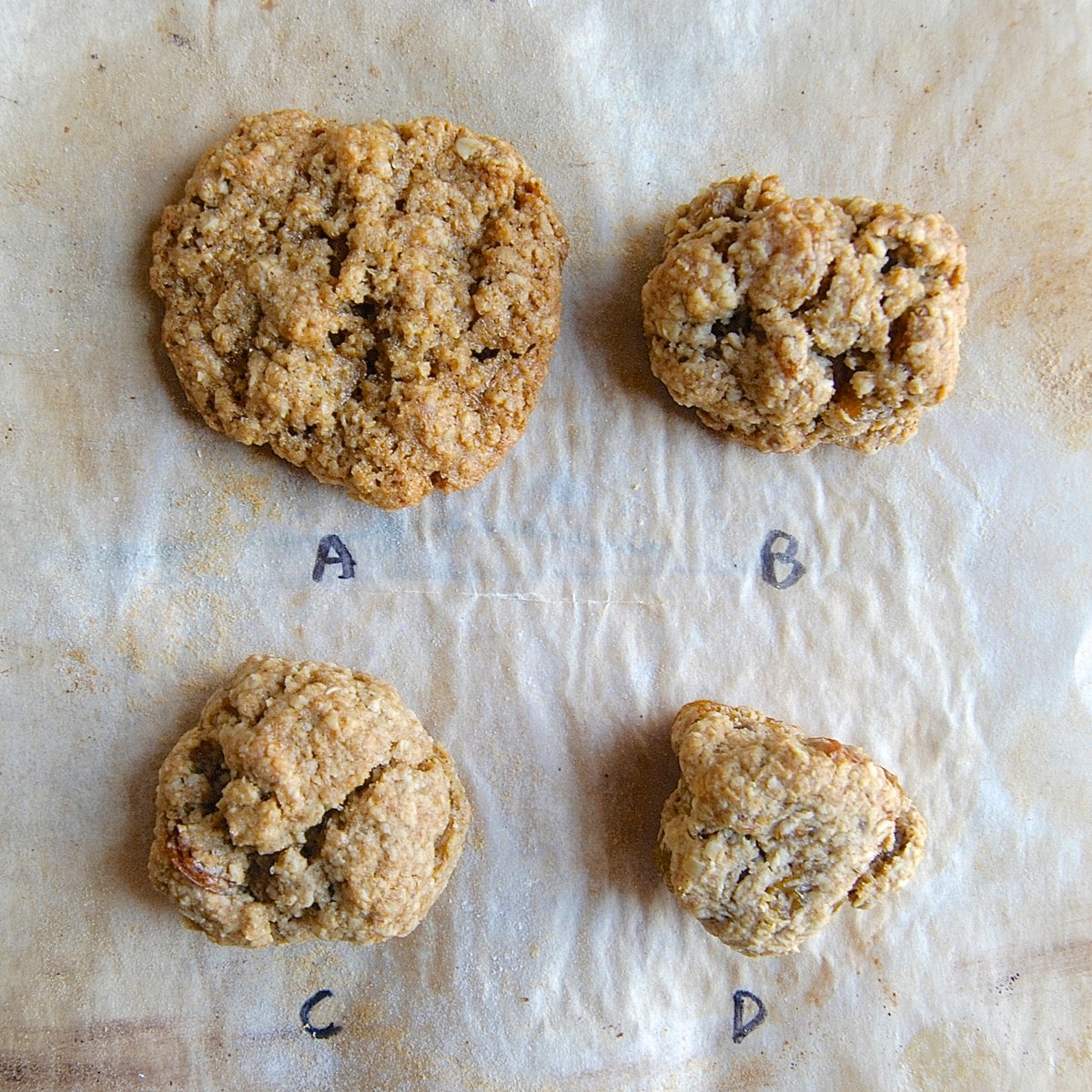
A) Original recipe (193% sugar): These cookies are flat, chewy, and very moist. They've got great flavor, with muted spices and lots of sweetness from the raisins — a typical good soft oatmeal cookie. PASS
B) 50% sugar, baker's percentage: With less spread than the control, these cookies are tougher, drier, and flatter tasting than A or C. The spices are coming forward in a not-so-pleasant way. FAIL
C) Half the sugar in the original recipe: They don't spread much, but these cookies are fairly moist. Their overall flavor is good, although the spices are quite strong. PASS
D) 25% sugar, baker’s percentage: These cookies show no spread at all, and they're hard and crumbly. Not only can you taste strong spice flavors, but the acrid taste of leavening, as well. FAIL
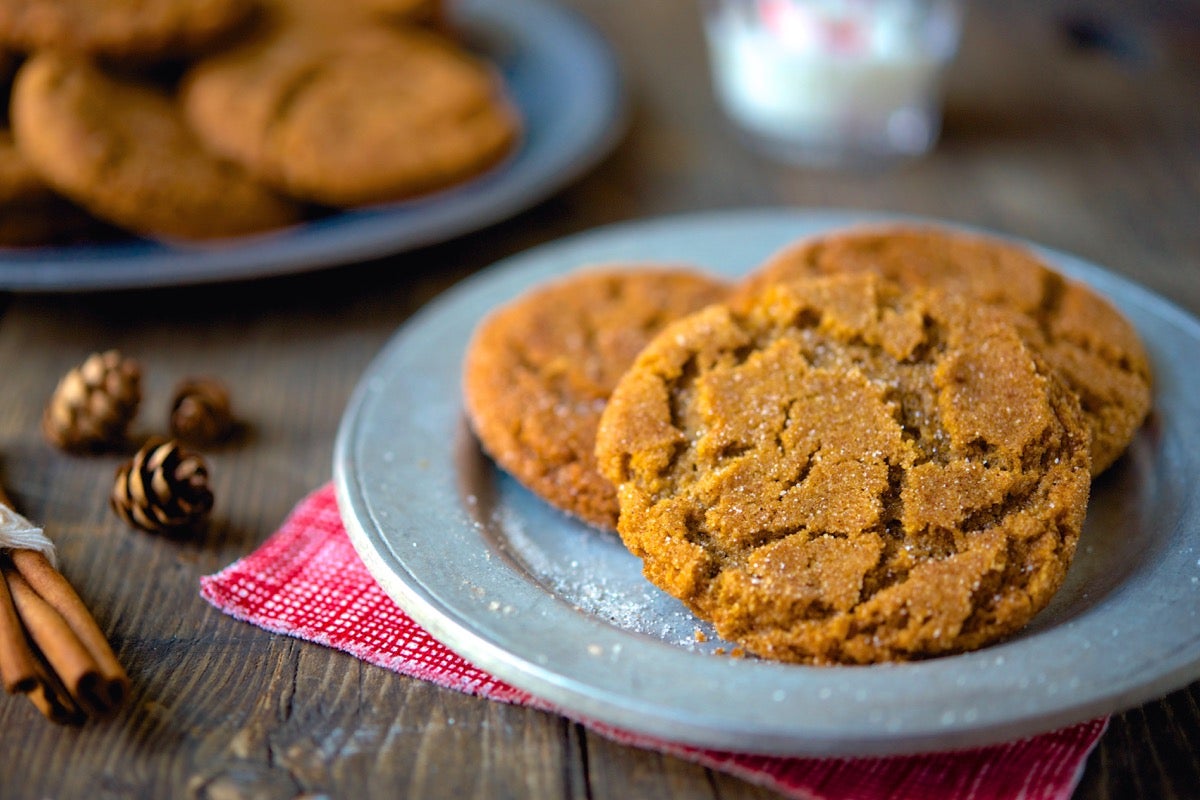
These are the ultimate crunchy cookie. Dark and spicy, they're a favorite at the holidays, but also delicious with a glass of lemonade in summer.
I like to roll these cookies in sugar before baking, but it's not a necessity; and I haven't included this extra sugar in my calculations.
Note: Since the baker's percentage sugar in these cookies is 103%, I tweaked the test a bit. Rather than test 50% of the original recipe and 50% baker's percentage, which would yield almost identical results, I tested versions including 75%, 50%, and 25% of the sugar in the original recipe — no baker's percentages.
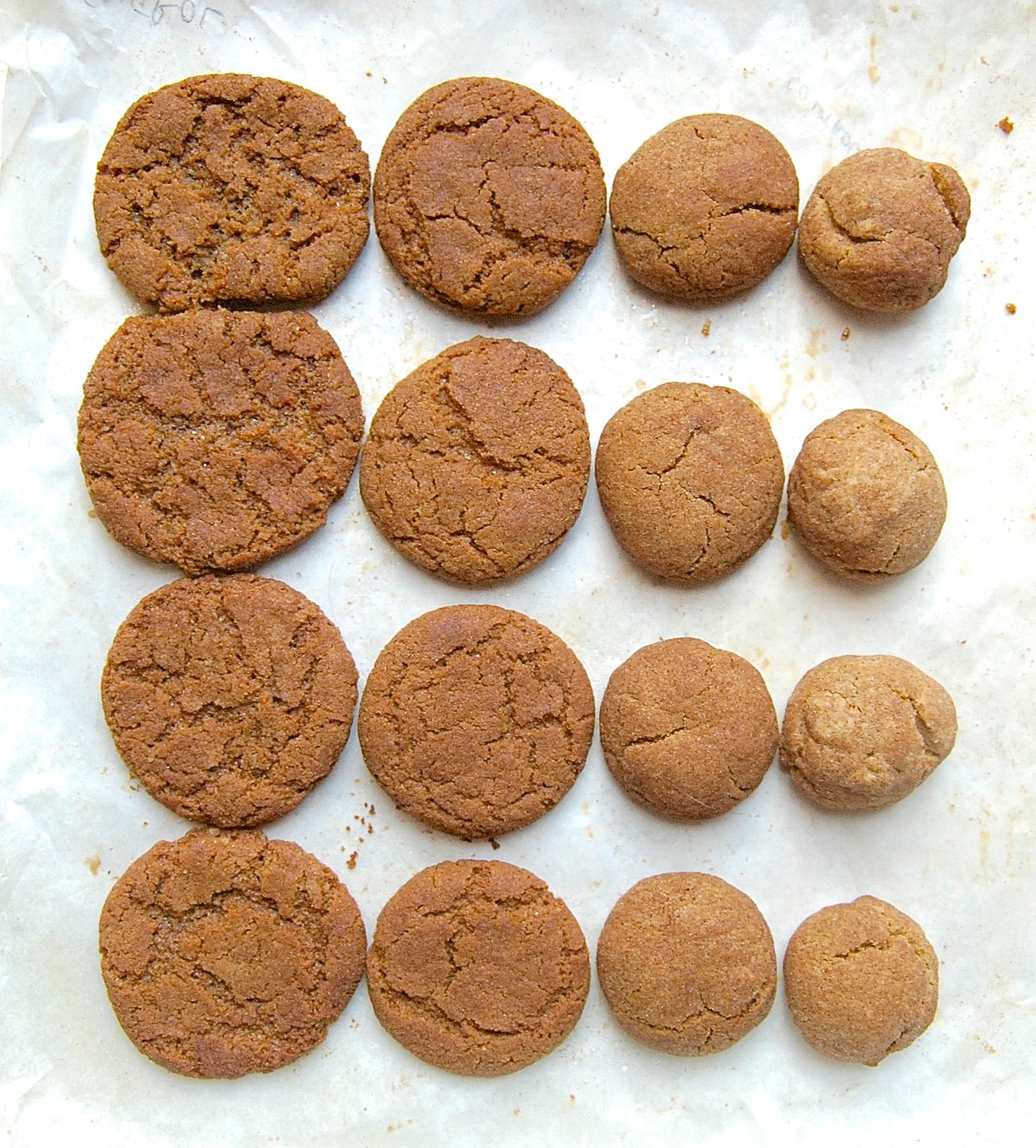
A) Original recipe (103% sugar): With good spread and crunchiness, and the perfect balance of sweetness and vibrant spices, these cookies are delightful. PASS
B) 75% of the sugar in the original recipe: Somewhat reduced spread yields crunchy edges and a softer center. The mild flavor of these cookies is somewhat one-dimensional. PASS
C) 50% of the sugar in the original recipe: With very little spread, these cookies exhibit a crumbly texture and minimal sweetness. Their spices taste harsh. FAIL
D) 25% of the sugar in the original recipe: These cookies show no spread; they're very tender/crumbly/dry. They taste like a biscuit with some added spice. FAIL
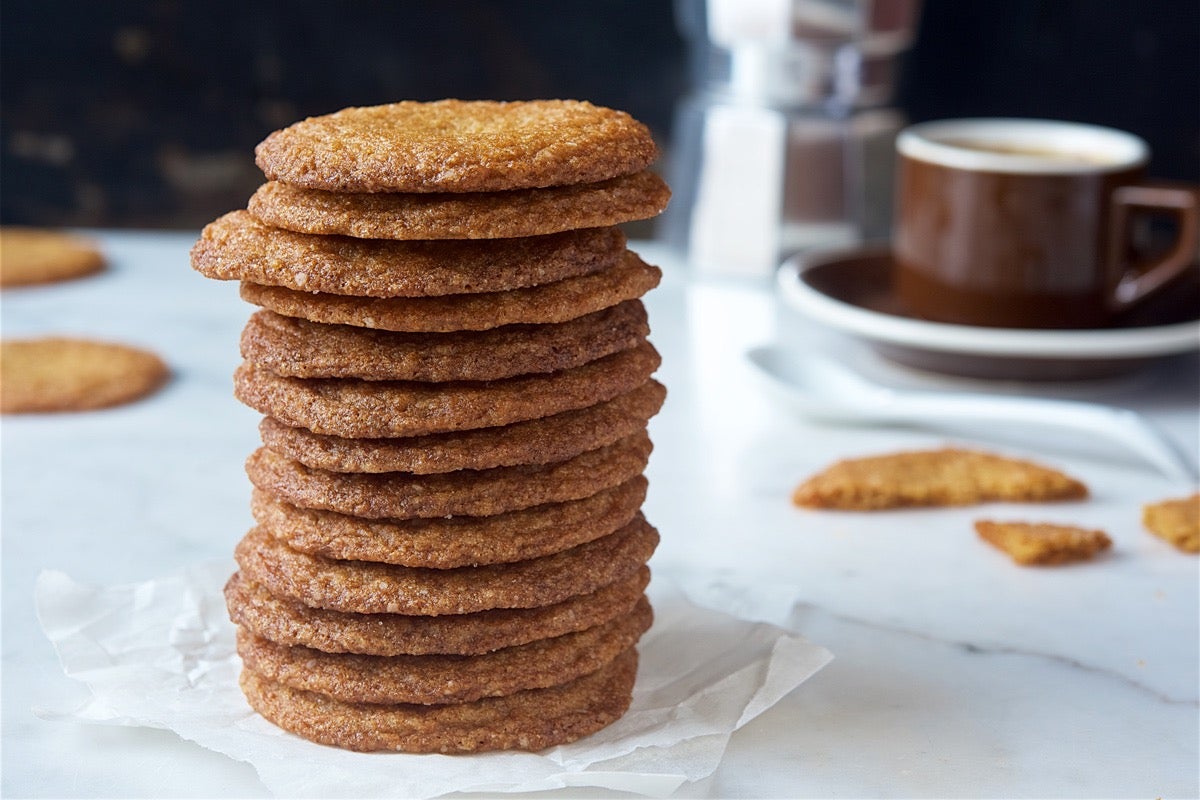
Crisp and thin as can be, Buttersnaps are dusted with both sugar (not included in the sugar calculations) and salt to enhance their caramelized flavor.
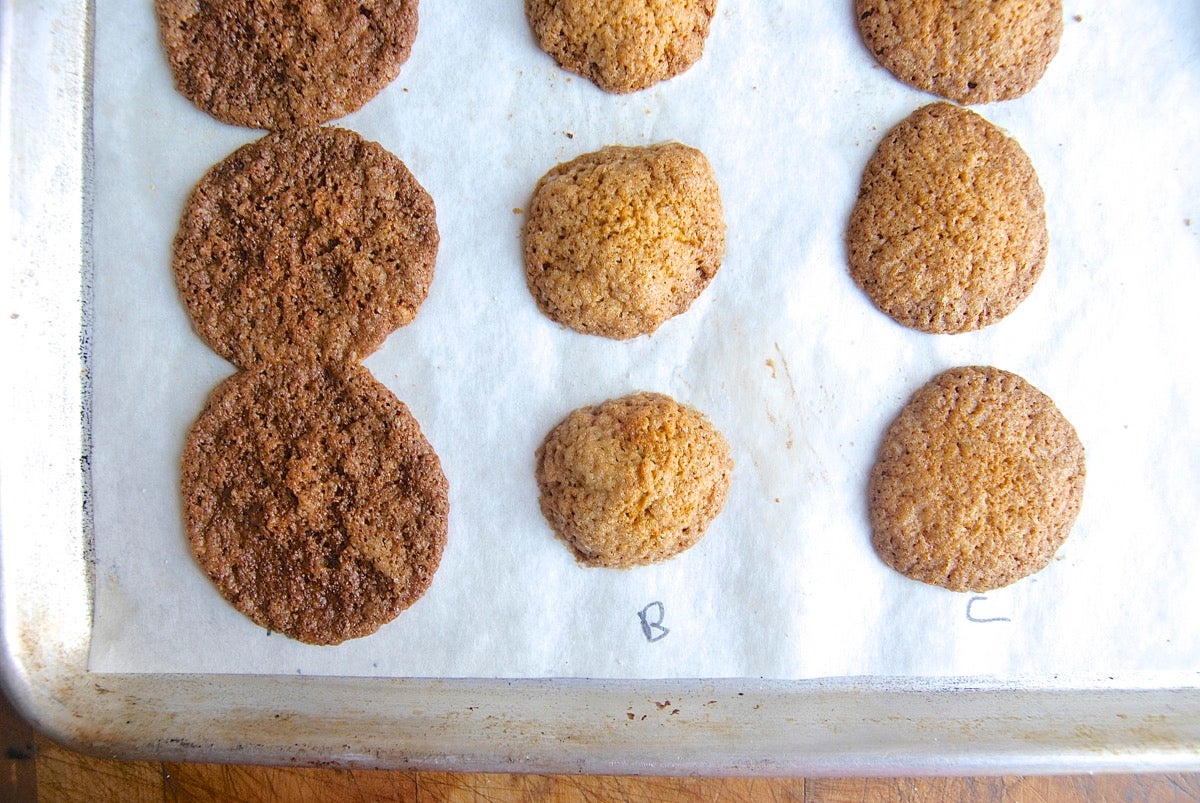
A) Original recipe (139% sugar): These cookies are absolutely snapping crisp. They're sweet, with a touch of caramel and butter flavor. PASS
B) 50% sugar, baker's percentage: Soft, dry, and somewhat crumbly, these cookies are only very mildly sweet; their flavor is dull. FAIL
C) Half the sugar in the original recipe: Crisp edges and a dry/tender center mark these cookies. They're mildly sweet, with a tiny hint of bitterness from the leavening. Their better flavor/texture is at the edges, which makes sense: sugar migrates outwards as the cookies bake. PASS
D) 25% sugar, baker’s percentage: These cookies are dry/crumbly all the way through. Their predominant taste is salt/bitter (leavening). FAIL
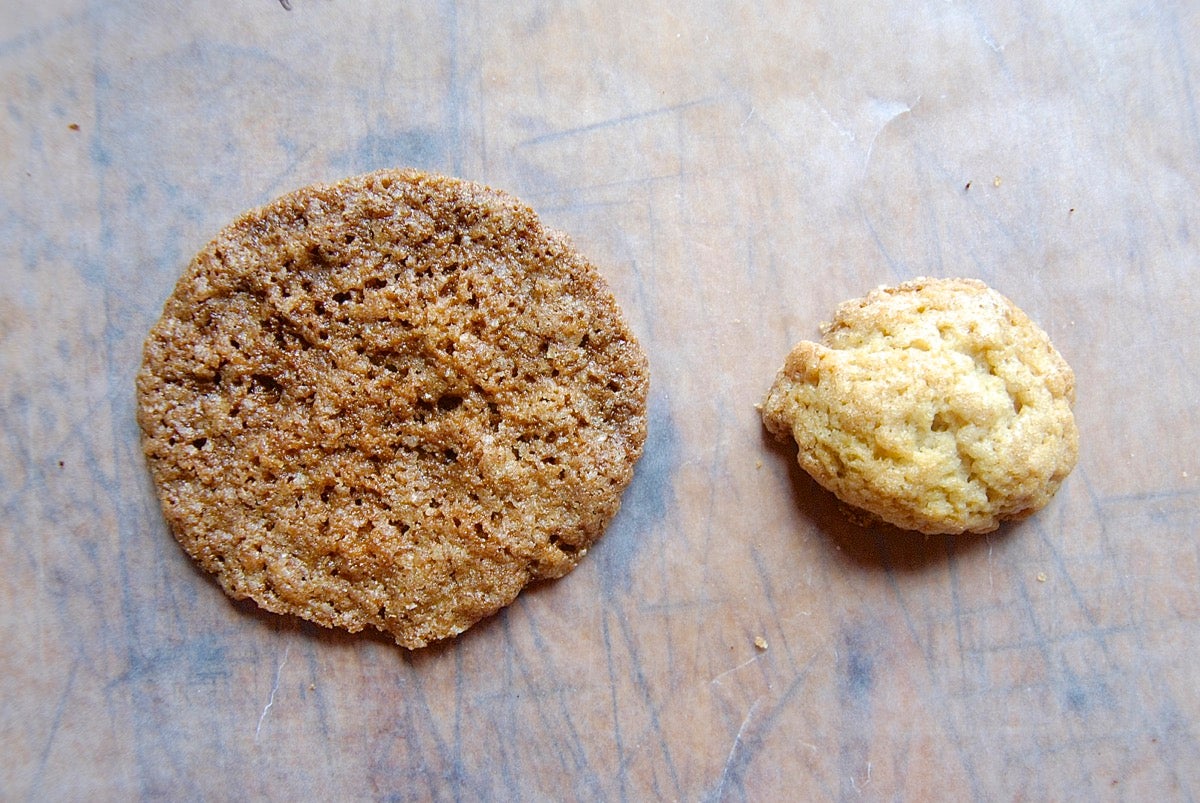
Note the difference between the control cookie (left) and cookie D (25% sugar), right. These are the highest-sugar cookies I tested, so clearly sugar is critical to both their texture and flavor.
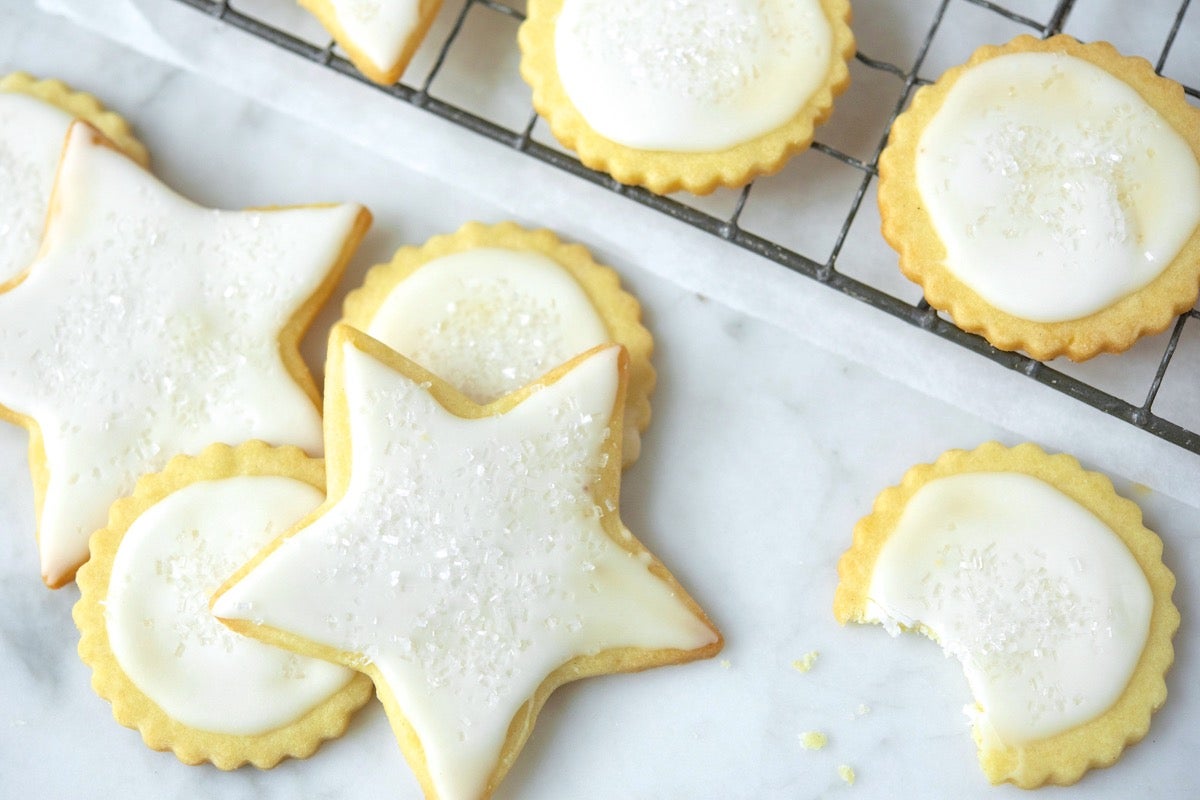
This is my favorite cutout cookie recipe. The dough is easy to work with, and the resulting cookie is crisp without being hard, with a touch of tenderness.
Note: These are the only cookies where reducing sugar doesn't change their spread at all. This makes sense, since they're also the lowest-sugar cookie in the test.
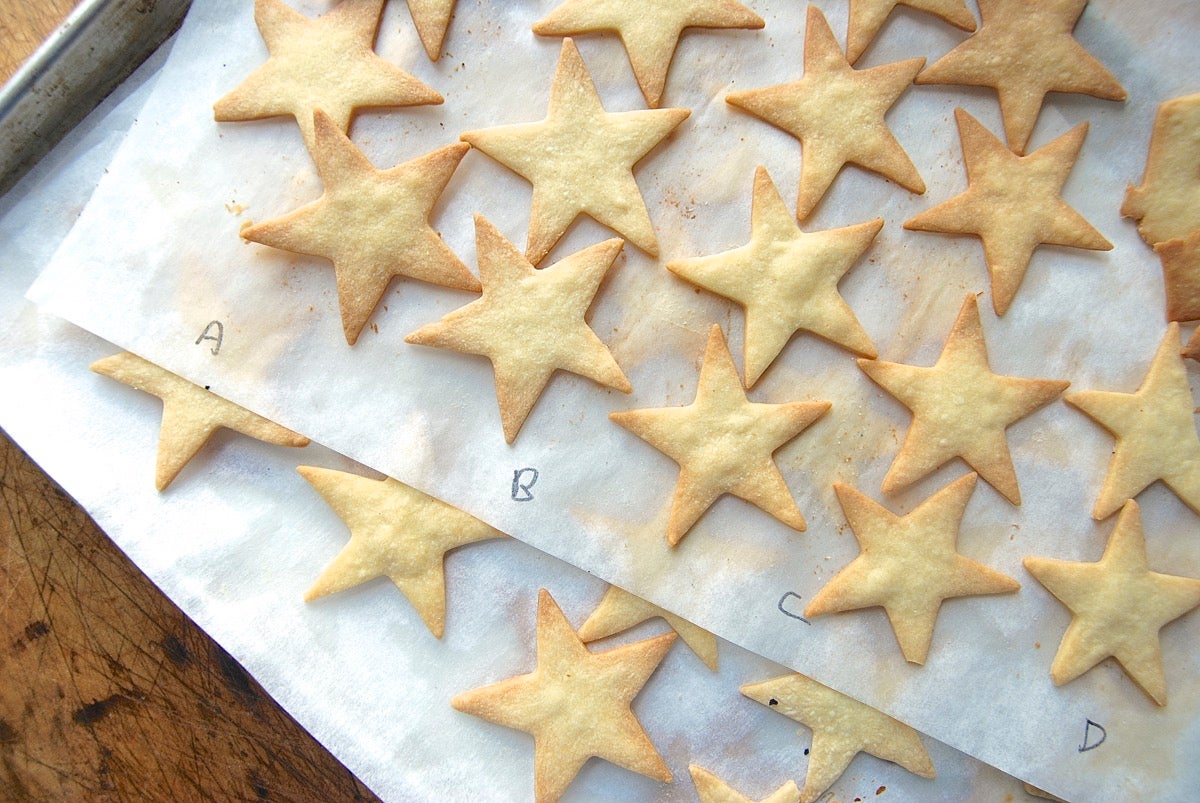
A) Original recipe (43% sugar): Cookies are nicely crisp, with a touch of tenderness. They have good balanced flavor, and would be enjoyable without icing. PASS
B) 50% sugar, baker's percentage: Crisp, with a touch of tenderness, the texture of these cookies is identical to the control. Flavor is slightly sweeter. PASS
C) Half the sugar in the original recipe: Cookies are tender, not crisp. While mildly sweet, they're starting to taste boring; icing or sprinkles would enhance their flavor. PASS
D) 25% sugar, baker’s percentage: These cookies are tender, not crisp; their texture is identical that of "C." Flavor-wise, they're almost like pie crust; icing is a requirement here. PASS
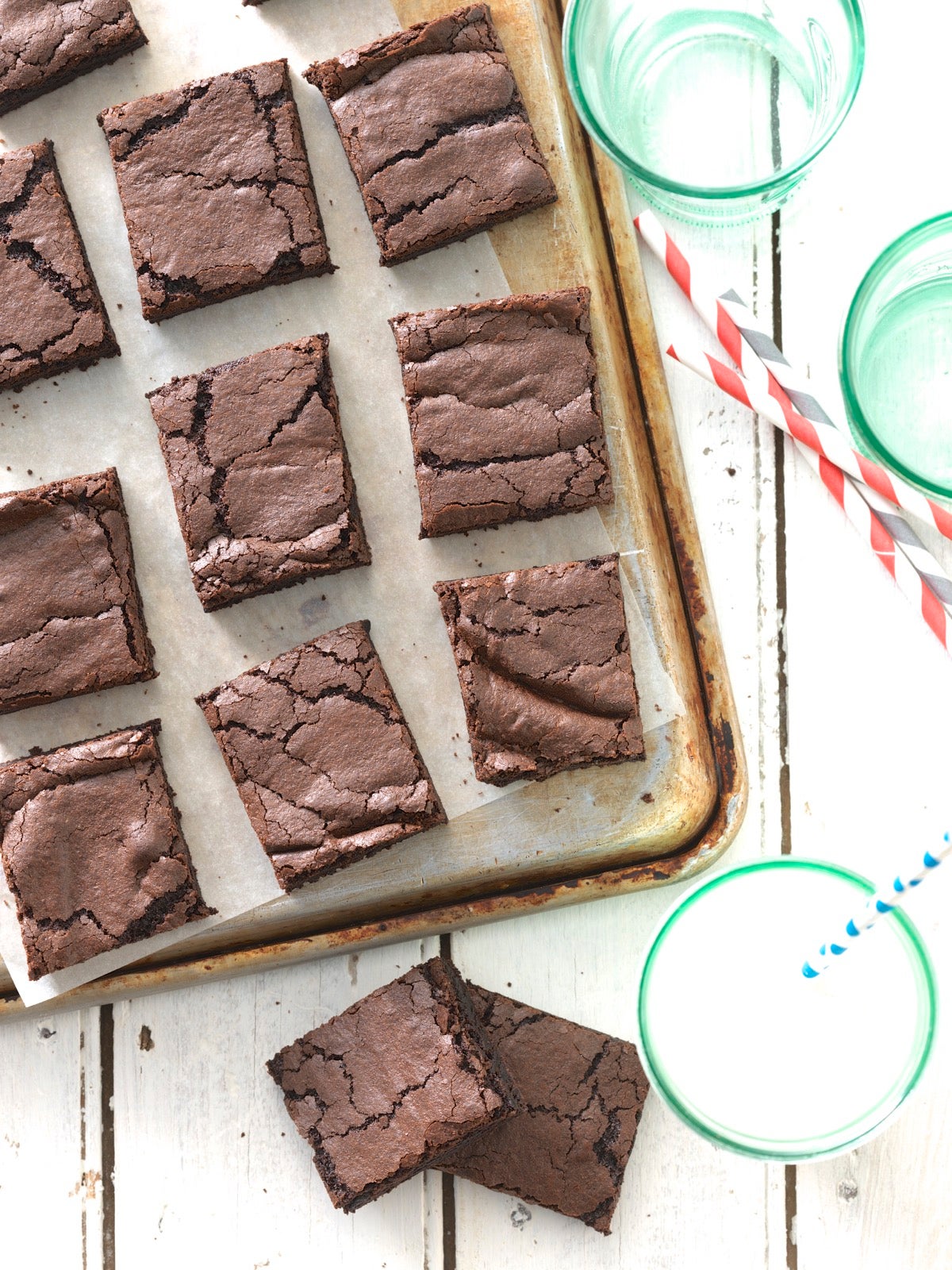
These super-moist, chewy brownies are thin rather than thick. Their flavor is deeply chocolate, though semisweet rather than bittersweet.
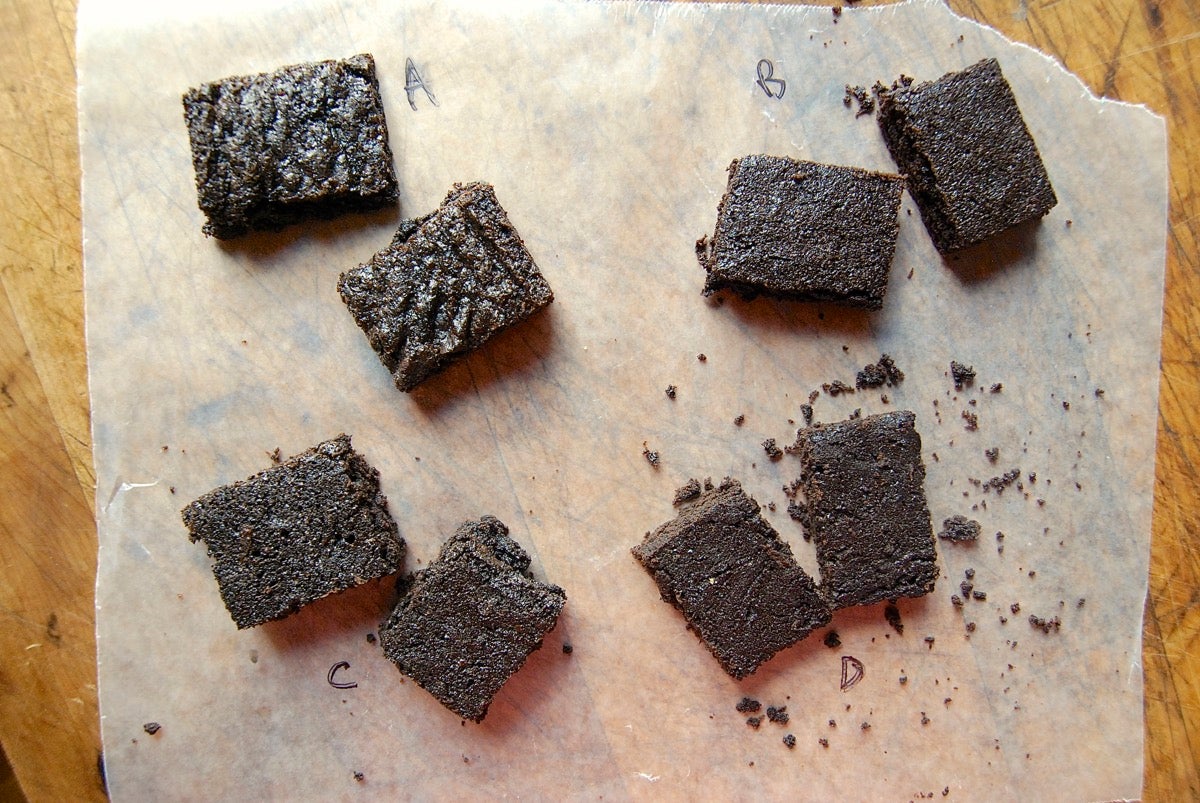
A) Original recipe (289% sugar): Typical brownie texture: moist & chewy, with a mild sheen to the top crust. They have good chocolate flavor, though quite sweet. PASS
B) 50% sugar, baker's percentage: These brownies are dry, crumbly, and barely rose in the pan. Their taste is unpleasant, bitter from the cocoa. FAIL
C) Half the sugar in the original recipe: The texture of these brownies is cakier than the control, but still retains a degree of moistness and chew, with just a tiny bit of crumbling. Their flavor is excellent: deep chocolate, without a hint of being too sweet. PASS
D) 25% sugar, baker’s percentage: These very crumbly and dry brownies exhibit unpleasant flavor, with a strong taste of bitter cocoa and noticeable lack of sugar. FAIL
Note: I also tested these brownies with a 25% reduction in their original sugar. The result? Delicious. They're very similar to the control, with even better flavor thanks to the slight reduction in sweetness — which lets the chocolate shine through.
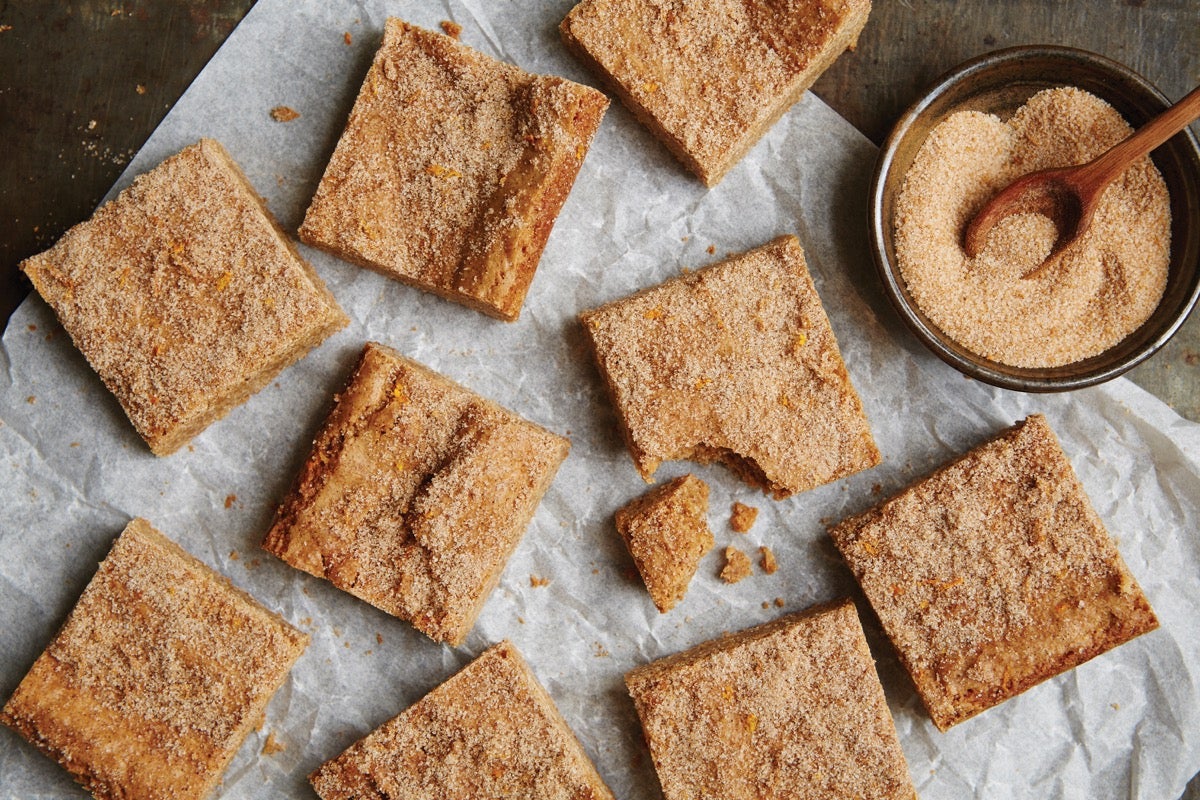
These bars puff up as they bake then fall as they cool, yielding a bar with dense, moist, chewy texture. They're pleasingly sweet, and aromatic with spice. Note: The sugar on top, while a nice element, isn't critical to the texture of the bars themselves; and I haven't included it in the sugar calculation.
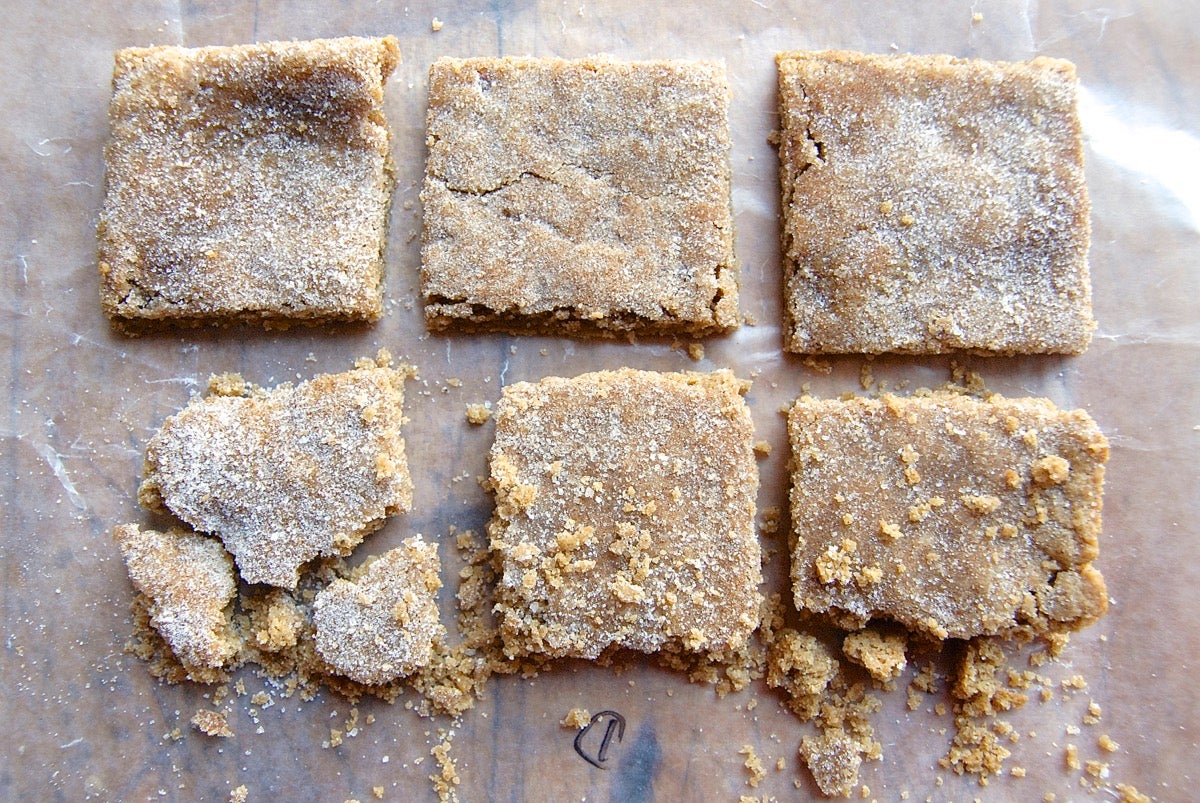
A) Original recipe (200% sugar): The texture of these bars is fudgy brownie-like, chewy and moist. Their pleasing flavor relies on sophisticated spices, including cardamom, which add an air of elegance. PASS
B) 50% sugar, baker's percentage: Bars are extremely crumbly. Their flavor is totally unremarkable; they're somewhat sweet, but the sweetness is overpowered by spice. FAIL
C) Half the sugar in the original recipe: Texturally these bars are a bit moist, though noticeably crumbly. They're definitely sweet enough, with good overall flavor. PASS
D) 25% sugar, baker’s percentage: These dry, crumbly, unpleasant bars are so delicate you can barely pick one up. Their flavor is mildly sweet, but the spices are very prominent: unpleasantly so. FAIL
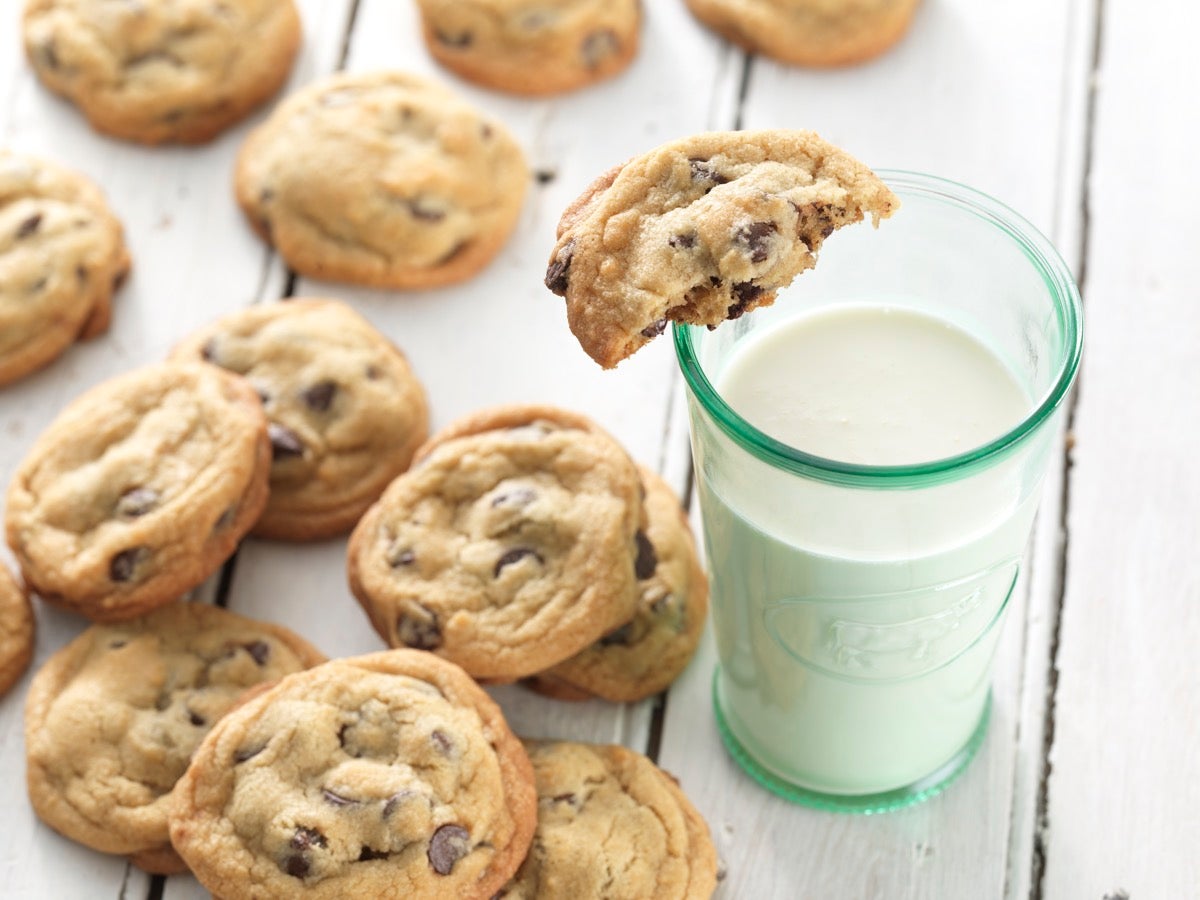
My favorite chocolate chip cookie is tender/crisp around the edges, and softer in the center. Its flavor is butter and caramel and chocolate, all playing harmoniously off one another.
Interestingly, all four iterations earn passing grades from me — proving that even sub-par chocolate chip cookies are pretty darned good!
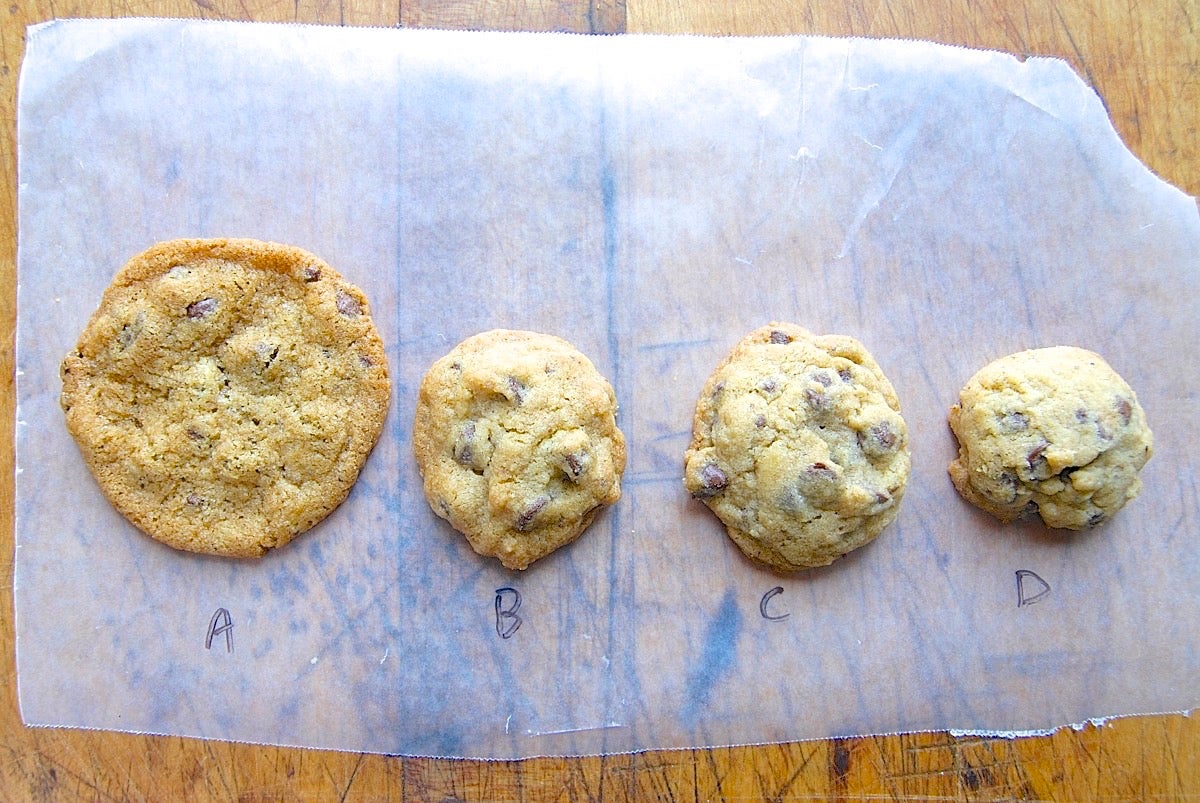
A) Original recipe (113% sugar): These cookies spread into perfect rounds, with wonderfully crunchy edges and a slightly soft/bendy center. Sweetness and chocolate predominate; butter is a secondary flavor. PASS
B) 50% sugar, baker's percentage: With much less spread, these cookies are soft, dry, and tender, rather than crispy or crunchy. There's a tiny bit of crunch on the edges. Though somewhat sweet, chocolate is the predominant flavor, with a strong hit of butter. PASS
C) Half the sugar in the original recipe: Identical to B. PASS
D) 25% sugar, baker’s percentage: These cookies exhibit wonderfully tender/crumbly/cakey “melt in your mouth" texture. With the merest hint of sweetness, chocolate and butter predominate; they're almost like buttery pie crust served with a smear of chocolate. A hint of leavening flavor starts to peek through. PASS
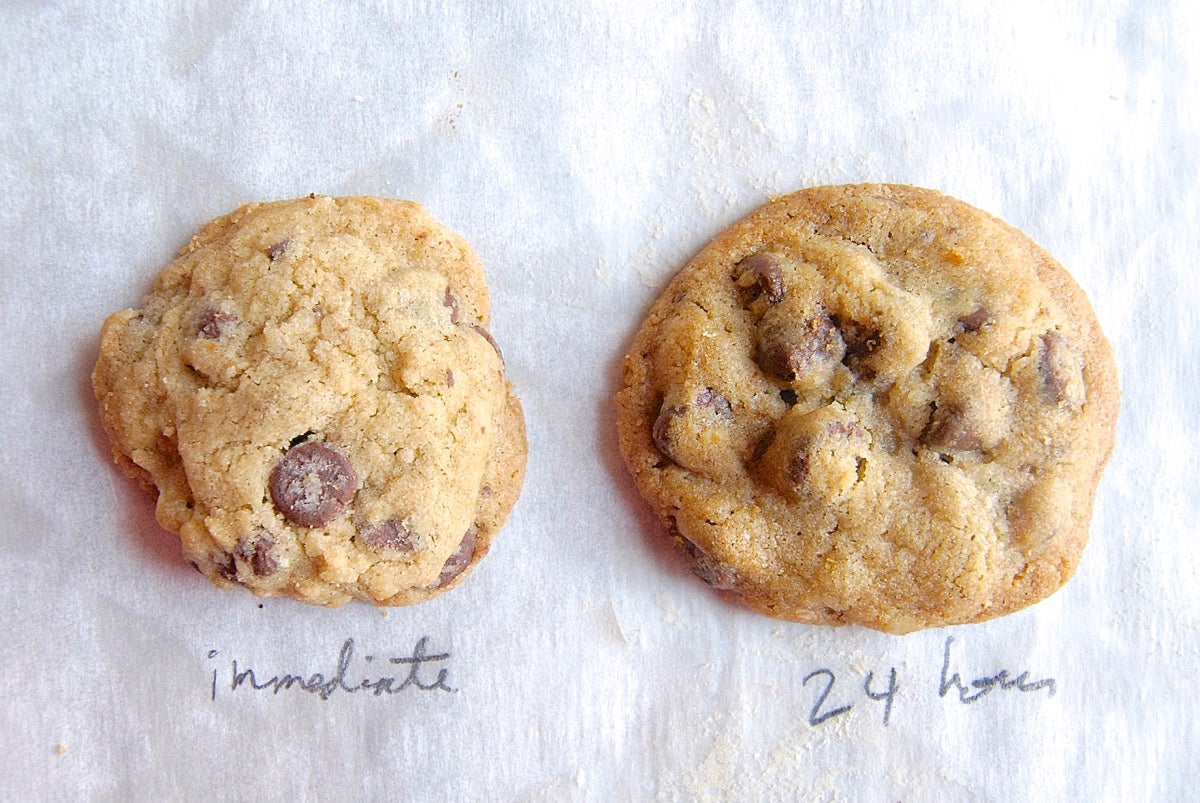
One last experiment with cookie B: Here's what chilling the dough for 24 hours accomplishes. The chilled-dough cookie (on the right) is darker/more caramelized, and thus tastes better (richer, more complex). It also spread about 20% more, which means the edges were thinner/crispier.
So, we've come to the end of our data — what's the bottom line?
Reducing sugar in cookies compromises their texture, usually quite drastically. Reducing sugar also affects cookies' overall flavor: less-sweet cookies reveal more background flavors, which can be good (butter) or not (bitter cocoa, harsh spices).
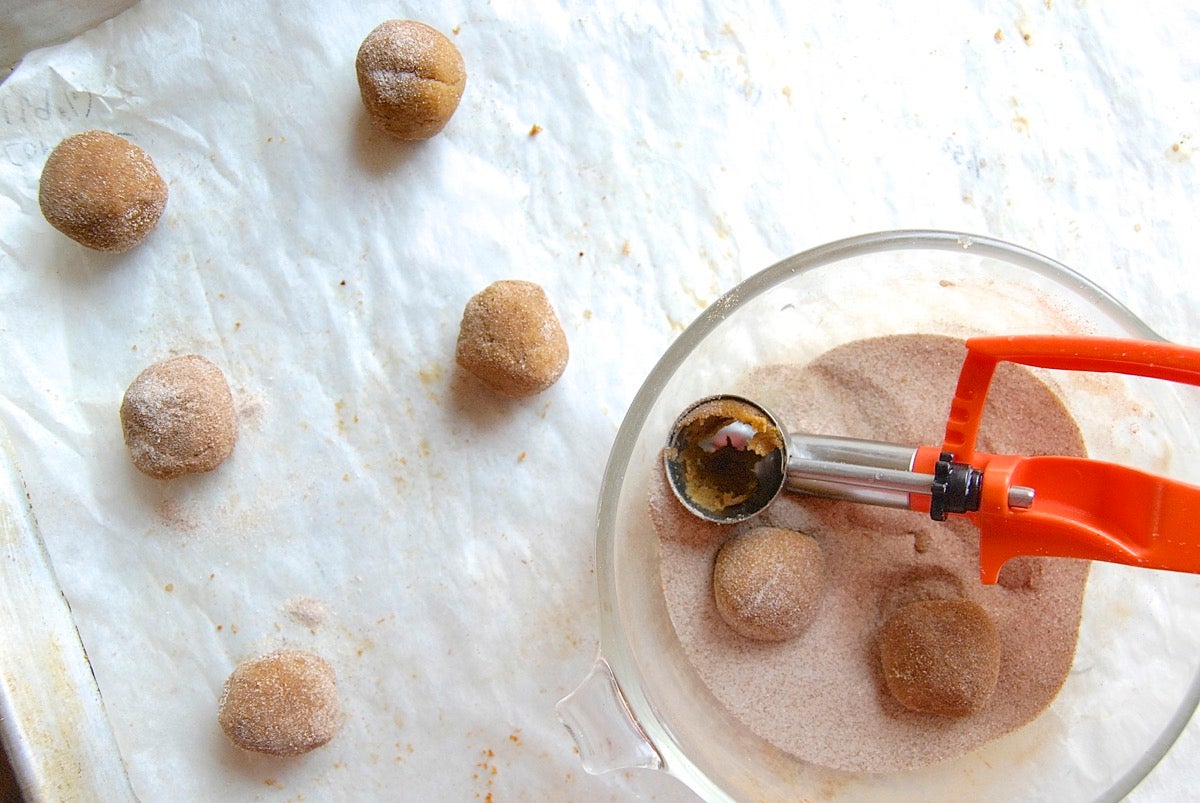
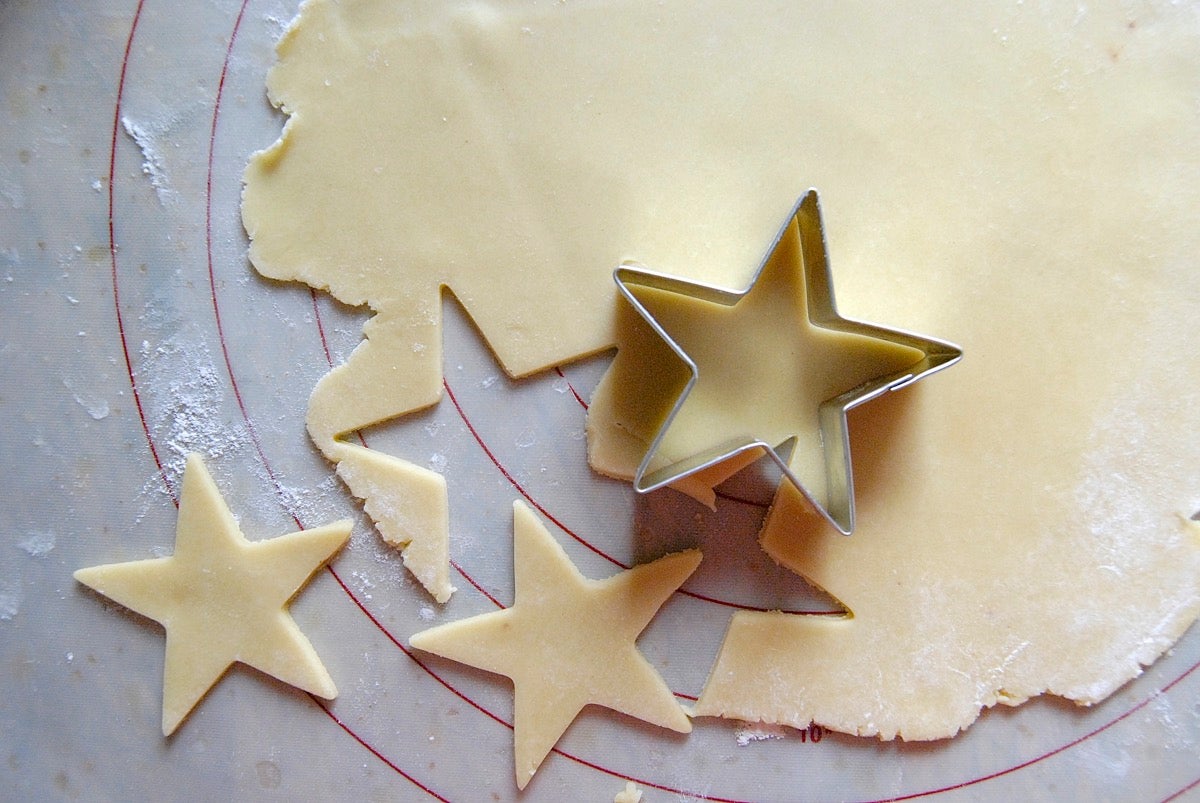
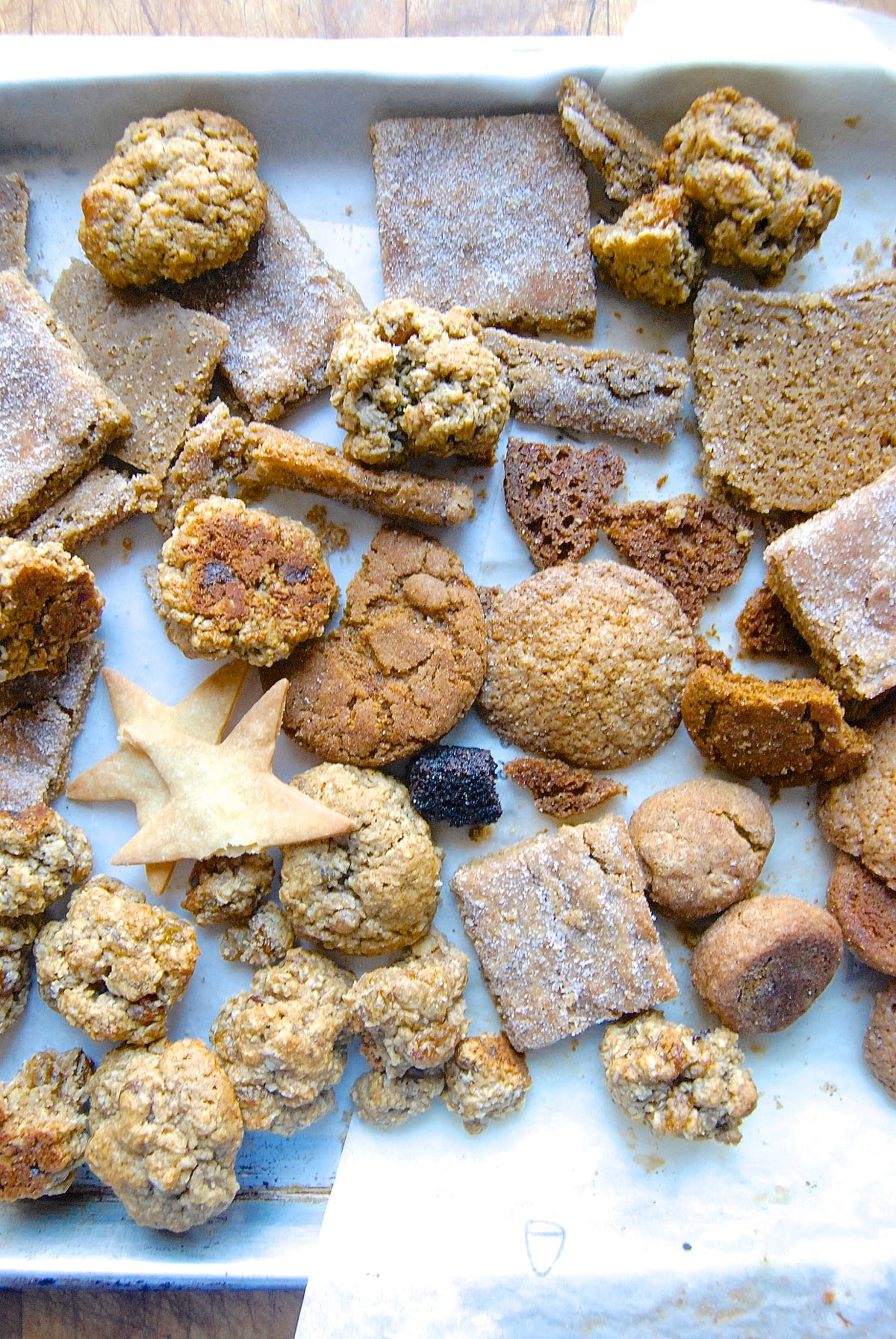
If you want to successfully reduce sugar in your cookies and bars in a way that relies on science rather than guesswork, embrace baker's percentage. That means you need to bake with a scale; or at least use a weight chart to determine the weight of the flour and sweeteners in your recipe.
Note: If your recipe includes liquid sweeteners (honey, molasses, maple syrup, et. al.), Google the weight of the liquid sweetener to determine its sugar content (weight) when figuring the weight of sugar in your original recipe. E.g., Google "Sugar in 100g honey."
For drop cookies: First, determine the baker's percentage of sugar in the cookie recipe you're using (remember, that's the weight of the sugar in the recipe divided by the weight of the flour).
If that percentage is 100% or higher (i.e., there's at least as much sugar, by weight, in the recipe as flour), then you can halve the sugar in your recipe and obtain decent (though not stellar) results. Cookies will taste mildly sweet, though their texture will be dry/crumbly/tender, rather than crisp, or soft, or crunchy.
If the baker's percentage of sugar in the original recipe is lower than 100%, try reducing the sugar in the recipe by just 25% to start. If you enjoy the results, edge lower on your next attempt.
For cutout cookies: Sugar can be cut down to 25% baker's percentage and produce a cookie with texture nearly identical to that in the original recipe. If you're going to ice cookies (and thus increase their sweetness), you might as well start with a lower-sugar cookie.
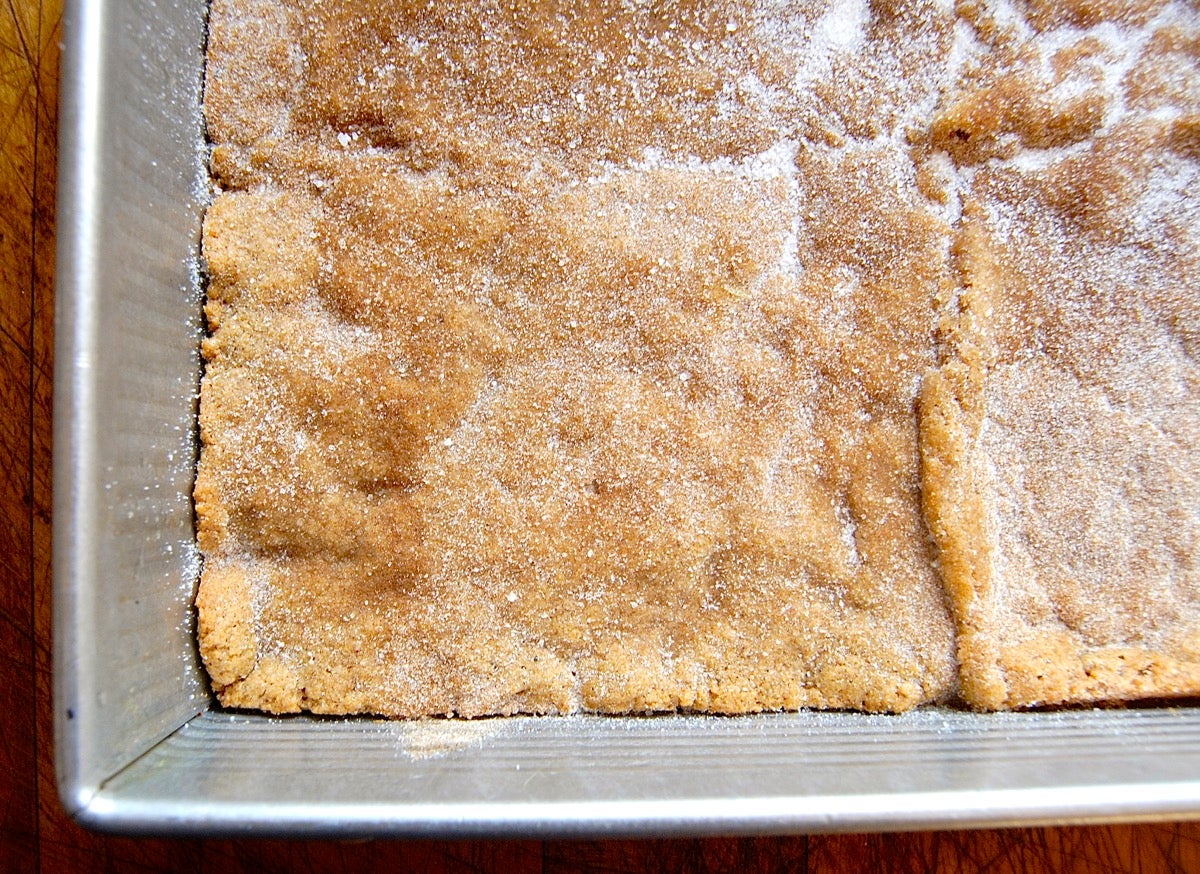
For non-chocolate bars: Non-chocolate bars can be reduced to a baker's percentage of 100% sugar, flavor-wise; but their texture will be cake-like and crumbly, rather than moist, soft, and chewy.
For brownies: In general, brownies aren't a good candidate for a major sugar reduction, as a significant amount of sugar is necessary to balance the bitterness of the cocoa or unsweetened chocolate in the recipe.
Try a 25% reduction in sugar from the original brownie recipe first. If you like the result, reduce the sugar still further in subsequent bakes; you should be able to reach a 50% reduction from the original while still enjoying a good-tasting brownie (though its texture will be veering towards cakey/crumbly).
That's a whole other ball game! We've tried artificial sweeteners in cookies and bars in the past, and have been unimpressed with the results. So for now, we're concentrating on adjusting the level of standard sweeteners.
Do you have any tips to share with fellow bakers wanting to reduce the sugar in cookies and bars? Please add your thoughts in comments, below.
Want more information on reducing the sugar in your baking? Read these posts:
How to reduce sugar in muffins
How to reduce sugar in cake
How to reduce sugar in yeast breads
How to reduce sugar in pie